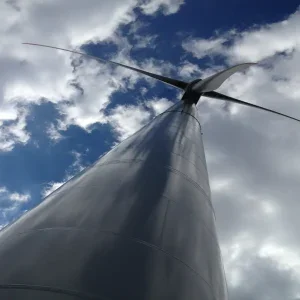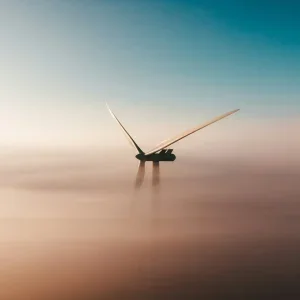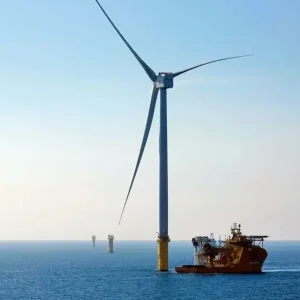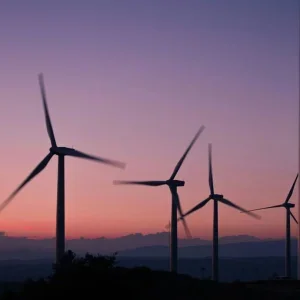Innovation is the force driving wind power, and this desire for better and more efficient energy is not limited to turbine, blade and tower technology. Inventiveness and creativity are being applied to every aspect of the industry, as exemplified by Siemens Gamesa Renewable Energy (SGRE)’s approach to logistics.
The company recently completed a new plant for the production of offshore nacelles in Cuxhaven, in the Lower Saxony region of Germany. The €200-million investment created the largest and most advanced plant of its type in the country and is situated in a port that will play a pivotal role in a new transport system, which has been three years in the making.
The new infrastructure will provide an efficient link between an offshore production site in Cuxhaven and the rotor blade factory in Hull, UK, using two custom-built transport ships. As a result, the company now relies entirely on maritime logistics for delivering its offshore technology.
Using a roll on/roll off (ro-ro) logistics concept to replace conventional road transport and crane loading, the company is now able to supply heavy-duty components more safely and efficiently. Based on its operation of the system to date, SGRE estimates that it will be able to deliver expected savings of up to 20% in logistics costs compared with conventional transport methods.
“Siemens Gamesa and its legacy company, Siemens Wind Power, did a comprehensive analysis of suitable sites for the offshore manufacturing footprint,” says Thomas Mortensen, SGRE’s head of logistics execution. “Since the UK and Germany are key markets in offshore wind, Hull was chosen for the blade plant and Cuxhaven for the establishment of a nacelle plant. Cuxhaven and the State of Lower Saxony region offered strong political support and also a well-prepared site directly at the harbour. The State of Lower Saxony also invested millions in the port infrastructure in Cuxhaven, including the construction of a ro-ro ramp.
“The establishment of a production facility in Germany allowed SGRE to operate in the centre of the German market and other European offshore markets.
“Located directly at the waterfront, the Cuxhaven facility eliminates expensive road transportation and heavy component lifting of nacelles through ro-ro transportation. From there, they are directly shipped to the offshore sites worldwide. Thus, it immediately contributes to cost reduction. The new factory contributes to the continued industrialisation and standardisation efforts of offshore production, logistics and supply chain management, thereby contributing to affordable offshore wind energy.”
Taking the load from the road
At the Cuxhaven nacelle plant, SGRE assembles the nacelles for wind turbines used at sea and the processes in the plant, as well as the transport to the marine wind power plants, are designed for maximum efficiency in order to further reduce the costs of offshore power generation. Construction work on the 55,000m² factory began in June 2016 and production started in mid-2017.
The site of the factory, which is in close proximity to the edge of the Germany North Sea port, allows the direct transportation of large and heavy wind turbine components by ship to offshore installations.
The facility incorporates digital material flow control to ensure the availability of all components in the correct sequence, and industrial robots equip the generators with magnets and ensure optimum product quality, before the nacelles undergo digitally controlled test processes.
Once complete, they are loaded onto a purpose-built transport ship, the Rotra Vente, which is an essential part of ro-ro logistics, which SGRE believes represent a huge step forward in improving safety, as well as delivering significant savings.
The Rotra Vente is just one of two 140m-long ships operated by Deugro Danmark on behalf of SGRE. In one journey, it can transport eight canopies of the current Siemens Gamesa 7MW-class wind turbine a journey.
The other ship, the Rotra Mare, can hold three complete wind power towers, each with three sections, or up to 12 rotor blades, and transports them from the production site in Hull, UK, or from Aalborg, Denmark, to the respective installation port.
To date, the ships have made more than 150 voyages and have supplied components for around 300 wind turbines to eight different offshore wind projects. Without the use of ro-ro loading, this would have required more than 2,000 crane operations.
“The project progressed rapidly after an investment decision was taken in summer 2015,” comments Mortensen. “Less than two years later, in July 2017, the production started with the ramp up process, which allowed the first nacelle deliveries in early 2018. Keeping in mind the size of the project, we see this as extremely fast progress. The new production facility covers around 17ha, or 170,000m². This corresponds to an area of around 24 football pitches. In addition, option areas of the order of 18–21ha are designated for a further couple of years.”
A project of this scale highlights the growing challenges of transporting increasingly large and heavy wind turbine components by road. Already, the permissible limits on axle loads and clearance heights are being reached, which makes the maritime logistics concept a timely one. Now, tower sections weighing up to 200t and canopies weighing more than 360t can be rolled out of the factory directly onto the transport ships.
Nevertheless, it represents just the latest round of innovation for a company that has its sights firmly fixed on the future.
“The industrialisation in offshore wind is an ongoing process,” notes Mortensen. “Since the wind turbine costs account for less than 30% of total costs of offshore wind, we are aiming to improve all aspects of wind energy at sea. One area of focus is the wind turbine service, which will benefit even more from digital developments. For example, we are currently testing drones that autonomously capture images of rotor blades.
“These images are analysed by an AI-based tool to identify potential damage and the need for refurbishment. In only a few years, we will be able to deploy robots to carry out the respective repairs. But this blade integrity management is only one example for progresses in the offshore wind service.
“Over the past few years, we have made progress in service efficiency by operating our SOVs – specialised vessels that serve our technicians in the offshore wind farm as workshop and accommodation at the same time. These vessels save long transfer times and help to keep the availability of the wind turbines at a very high level.
“Combined with our digital remote diagnostic services, maintenance work can be planned with a predictive schedule that has raised the efficiency of this work to a new level and allows us to deploy single SOVs over multiple offshore wind power plants.”
A model of collaboration
The willingness of the State of Lower Saxony to partner with SGRE in the development of facilities at Cuxhaven is an indication of how beneficial the project is for the local economy, as well as for the company and the wind power industry as a whole.
This plant is the largest production facility of its kind in Germany and is expected to employ around 850 people by the end of 2018. More than half of these new employees will be directly involved in manufacturing processes.
“The factory is already having an outstanding impact on the local economy and labour market since other industries like construction, hotels and small businesses also benefit from extra orders and secondary effects,” notes Mortensen.
The large investment in the plant, and the involvement of many different stakeholders, is proof that innovation is a collaborative process, and this ethos will no doubt shape SGRE’s plans for the future. With a capacity of 85GW installed worldwide, of which 11GW is offshore, and a history of pioneer projects dating back to 1991, the company has already established itself as a market leader, but it will rely on innovation to maintain that position.
SGRE is currently manufacturing the last of the 42 SWT 7.0-154 turbines at the new plant in Cuxhaven for the Rentel offshore wind power plant in Belgium. The canopies for the 588MW Beatrice wind power plant and the 1,218MW Hornsea One project, both of which will be installed in the British North Sea, will then be assembled there.
“With innovations like ro-ro logistics, use of factory digitalisation and efficient set-up, this investment has put us in the right position to gain competitive advantage, and we remain confident that this was the correct investment to make,” states Mortensen. “The Cuxhaven site is planned as an industry park that offers suppliers the option to establish their business directly on-site.
“Our logistics partner, Stute, and the Danish supplier, Nordmark, are good examples of how such a settlement can represent a meaningful investment for suppliers. We expect a lot more companies to come and contribute to the Cuxhaven offshore hub as a central location of the German offshore industry.
“The new production facility is also designed to facilitate the next generation of offshore wind turbines. The production of the already launched SG 8.0-167 DD will start in 2020. The factory also offers the required space and dimensions for future generations of turbine.”
With logistics defining much of the future development for the offshore wind sector, Cuxhaven provides a model that others may well choose to follow, not least for reasons of efficiency. Ro-ro could soon be the watchword among many of the industry’s big players.






